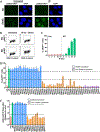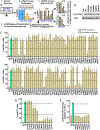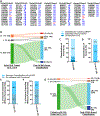Reclassification of ATM Missense Variants of Uncertain Significance by Integrating Results from Systematic Functional Assays into an ACMG Points-Based Framework
- PMID: 40105422
- PMCID: PMC12234152
- DOI: 10.1158/1078-0432.CCR-24-3936
Reclassification of ATM Missense Variants of Uncertain Significance by Integrating Results from Systematic Functional Assays into an ACMG Points-Based Framework
Abstract
Purpose: ATM is a moderate-risk cancer susceptibility gene that harbors thousands of missense variants of uncertain significance (VUS) which limit the power of clinical genetic testing for cancer risk management and personalized medicine. Functional tests provide a valuable basis for testing the impact of variants but have been lacking for ATM.
Experimental design: We developed a systematic approach to functionally characterize missense ATM variants based on the correction of various DNA damage-related phenotypes via reexpression of ATM in either of two ATM-deficient human cell lines.
Results: A pKAP1 phospho-flow assay for ATM VUS observed in patients with hereditary cancer was calibrated using 48 benign and pathogenic controls, achieving 100% specificity and 97% sensitivity. This system distinguished 82 of 88 (93%) missense ATM VUS of the FATKIN region as functionally neutral or deleterious. Importantly, for the clinical classification of VUS, functional results were incorporated into an American College of Medical Genetics points-based framework, also considering conservation and properties of amino acids/substitutions, along with genetic data; 79 of 88 (90%) were thereby reclassified as benign/likely benign or pathogenic/likely pathogenic. As additional validation of our approach, clinical characteristics from a database of 1,134 patients with breast cancer were distinct for carriers of neutral versus deleterious ATM variants. Also, utilizing our functional results, we identified hotspots for deleterious VUS and controls at amino acids 2702-2730 and 2891-2951 of ATM.
Conclusions: We have established functional assays as a reliable tool that will better interpret the clinical impact of ATM variants and guide improved cancer prevention measures for carriers.
©2025 American Association for Cancer Research.
Conflict of interest statement
Conflict of Interest Statement: The authors declare no potential conflicts of interest
Figures





References
-
- Savitsky K, Bar-Shira A, Gilad S, Rotman G, Ziv Y, Vanagaite L, et al. A single ataxia telangiectasia gene with a product similar to PI-3 kinase. Science 1995;268:1749–53 - PubMed
-
- Shiloh Y, Ziv Y. The ATM protein kinase: regulating the cellular response to genotoxic stress, and more. Nat Rev Mol Cell Biol 2013;14:197–210 - PubMed
-
- Thompson D, Duedal S, Kirner J, McGuffog L, Last J, Reiman A, et al. Cancer risks and mortality in heterozygous ATM mutation carriers. J Natl Cancer Inst 2005;97:813–22 - PubMed
MeSH terms
Substances
Grants and funding
- NIH R01 CA237016/National Institutes of Health (NIH)
- DFG GI WI 5377/2-1/Deutsche Forschungsgemainschaft
- R01 GM134731/GM/NIGMS NIH HHS/United States
- 70114178/Deutsche Krebshilfe (German Cancer Aid)
- UM1 TR004548/TR/NCATS NIH HHS/United States
- Ohio State University Comprehensive Cancer Center Biostatistics Shared Resource
- P30 CA016058/CA/NCI NIH HHS/United States
- NIH R01 GM134731/National Institutes of Health (NIH)
- R01 CA237016/CA/NCI NIH HHS/United States
- DKH70114844/Deutsche Krebshilfe (German Cancer Aid)
- NIH UM1 TR004548/National Center for Advancing Translational Sciences (NCATS)
LinkOut - more resources
Full Text Sources
Research Materials
Miscellaneous

